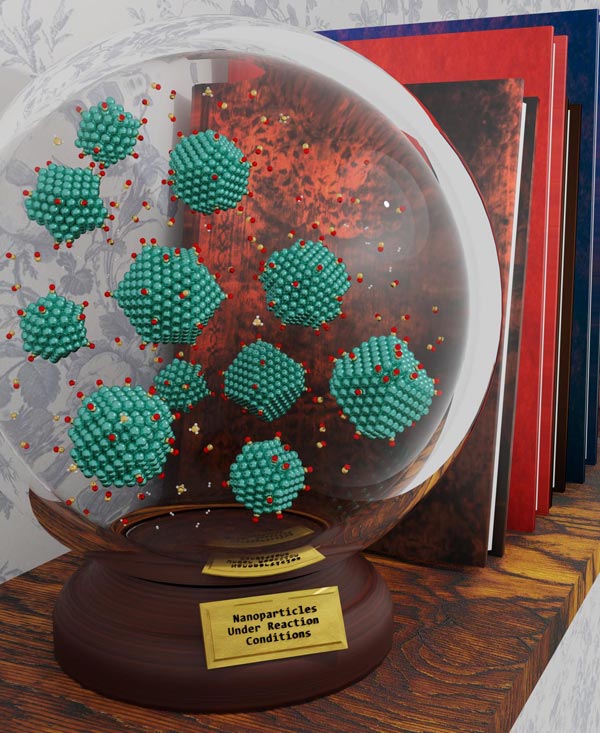Predicting unpredictable reactions

An illustration of nanoparticles under reaction conditions was featured on the cover of ACS Catalysis. Credit: Raffaele Cheula
Computational catalysis, a field that simulates and accelerates the discovery of catalysts for chemicals production, has largely been limited to simulations of idealized catalyst structures that do not necessarily represent structures under realistic reaction conditions.
New research from the University of Pittsburgh's Swanson School of Engineering, in collaboration with the Laboratory of Catalysis and Catalytic Processes (Department of Energy) at Politecnico di Milano in Milan, Italy, advances the field of computational catalysis by paving the way for the simulation of realistic catalysts under reaction conditions.
The work, published in ACS Catalysis, was authored by Raffaele Cheula, Ph.D. student in the Maestri group; Matteo Maestri, full professor of chemical engineering at Politecnico di Milano; and Giannis “Yanni” Mpourmpakis, Bicentennial Alumni Faculty Fellow and associate professor of chemical engineering at Pitt.
“With our work, one can see, for example, how metal nanoparticles that are commonly used as catalysts can change morphology in a reactive environment and affect catalytic behavior. As a result, we can now simulate nanoparticle ensembles, which can advance any field of nanoparticles application, like nanomedicine, energy, the environment and more,” says Mpourmpakis. “Although our application is focused on catalysis, it has the potential to advance nanoscale simulations as a whole.”
In order to model catalysis in reaction conditions, the researchers had to account for the dynamic character of the catalyst, which is likely to change throughout the reaction. To accomplish this, the researchers simulated how the catalysts change structure, how probable this change is, and how that probability affects the reactions taking place on the surface of the catalysts.
“Catalysis is behind most of the important processes in our daily lives: from the production of chemicals and fuels to the abatement of pollutants,” says Maestri.
“Our work paves the way towards the fundamental analysis of the structure-activity relation in catalysis. This is paramount in any effort in the quest of engineering chemical transformation at the molecular level by achieving a detailed mechanistic understanding of the catalyst functionality. Thanks to Raffaele's stay at Pitt, we were able to combine the expertise in microkinetic and multiscale modeling of my group with the expertise in nanomaterials simulations and computational catalysis of Yanni's group.”
Lead author Raffaele Cheula, a PhD student in the Maestri Lab, worked for a year in the Mpourmpakis Lab at Pitt on this research.
“It has been very nice to be involved in this collaboration between Yanni and Matteo” says Cheula. “The combination of my research experiences at Pitt and at PoliMi has been very important for the finalization of this work. It was a challenging topic and I am very happy with this result”.
###
The work is funded by National Science Foundation and the European Research Council, and with computational support from the Center for Research Computing at Pitt and CINECA in Bologna, Italy.
The paper, “Modeling Morphology and Catalytic Activity of Nanoparticle Ensembles Under Reaction Conditions,” was published in ACS Catalysis and featured on the cover of the print edition.
Media Contact
All latest news from the category: Physics and Astronomy
This area deals with the fundamental laws and building blocks of nature and how they interact, the properties and the behavior of matter, and research into space and time and their structures.
innovations-report provides in-depth reports and articles on subjects such as astrophysics, laser technologies, nuclear, quantum, particle and solid-state physics, nanotechnologies, planetary research and findings (Mars, Venus) and developments related to the Hubble Telescope.
Newest articles

Pinpointing hydrogen isotopes in titanium hydride nanofilms
Although it is the smallest and lightest atom, hydrogen can have a big impact by infiltrating other materials and affecting their properties, such as superconductivity and metal-insulator-transitions. Now, researchers from…

A new way of entangling light and sound
For a wide variety of emerging quantum technologies, such as secure quantum communications and quantum computing, quantum entanglement is a prerequisite. Scientists at the Max-Planck-Institute for the Science of Light…

Telescope for NASA’s Roman Mission complete, delivered to Goddard
NASA’s Nancy Grace Roman Space Telescope is one giant step closer to unlocking the mysteries of the universe. The mission has now received its final major delivery: the Optical Telescope…



